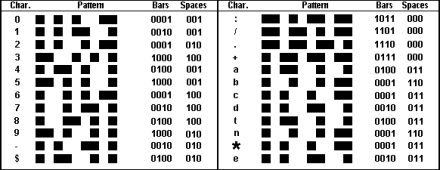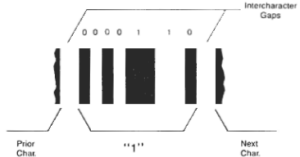ESE
Embedded Software Engineering
Decoding Codabar
Codabar
Codabar (sometimes called Code 2 of 7) is a discrete, self-checking, width-modulated
barcode with a character set providing the digits (0 - 9) and the special
characters (- $ : / . +). Additionally, there are four unique start/stop
codes represented by the characters A, B, C, and D.
Unlike the other width-modulated barcodes, Codabar doesn't use narrow and
wide element widths to directly encode the ones and zeros of the character
set. Instead, it specifies a total of 18 different sets of bar and space
widths. A fundamental characteristic of the Codabar encoding is that the
bars are decoded independently of the spaces. This structure was designed
to accommodate the printing errors characteristic of some early printers.
Each Codabar character is represented by seven elements: four bars and
three spaces. Of the seven elements, either two or three will be wide,
and the rest will be narrow. The lack of a fixed number of wide elements
per character lowers the data integrity of Codabar relative to other barcodes.
An inter-character gap, that is not part of the character itself, separates
the characters within the symbol. For the numeric characters (0-9) and
two of the special characters ($ -), there are two wide elements out of
the seven elements. These are encoded using one wide bar and one wide space.
The remaining special characters (:, /, ., +) and the start/stop characters
(A B C D) use three wide elements. The special symbols are encoded using
three wide bars. The start/stop codes are encoded using one wide bar and
two wide spaces. Note that the encoding provides a constant character length
regardless of whether two or three elements of the character are wide.
The Codabar character set encoding is shown in table 1.

Table 1 - Codabar Encoding
By convention, a narrow element is called the X dimension and all X dimensions
must be of equal size within the symbol. The dimension of a wide element
is a multiple of X. This ratio can vary within certain limits but once
selected remains consistent over the symbol. Generally, a wide to narrow
ratio in the range of 2:1 to 3:1 is acceptable.
Codabar is classified as a discreet code, in that the characters each stand
alone being separated from each other by an inter-character gap. Since
the inter-character gap is not an integral part of the character encoding
its dimension isn't critical and is generally made between X and 3X.

Figure 1 - Codabar Character '1' Encoding
Unlike other barcode symbologies, Codabar has four different start/stop
codes, represented by the characters (A B C D). Any one of these can be
used as a start code or stop code. The start/stop codes are generally used
in matching pairs and and can only be used on each end of the symbol. The
lack of a single start and stop code lowers the data integrity of Codabar
compared to other Barcodes. In addition to framing the symbol, the choice
of the start/stop codes can convey information, thus, most barcode readers
provide the option of whether or not to transmit the start and stop codes
as part of the symbol. An example of the codabar character "1" encoding
is shown in Figure 1.

Figure 2 - Complete Codabar Barcode Label
In addition to the bars and spaces that make up a barcode character and
the inter-character gaps that separate these characters, there is one more
component to a barcode label. This is the quiet zone, free of any printing,
to either side of the bar/space pattern. The quiet zone should be a minimum
of 10X. Now, with this information we can take the pattern of bars and
spaces to assemble a start code, some data characters, and a stop code.
Framing this with the requisite quiet zones results in a complete barcode
symbol shown in figure 2.
Decoding Codabar
The essence of a codabar decoding algorithm is an implementation of the
logic described in the AIM (Automatic Identification Manufacturers) Reference
Decode Algorithm for USS-Codabar.
Keep in mind that this is a basic algorithm. The underlying logic is sound
but can be significantly expanded. You might want to add secondary checks
for acceleration, inter-character gap, and absolute dimensions. Realize,
that these secondary checks could add as much code as the basic algorithm
itself. As a result, the underlying logic of the algorithm would be obscured.
It's not unusual to encounter barcode labels that aren't up to the specification
for a variety of reasons. This may be due to dimensional tolerance problems,
ink spread, poor print contrast ratio, inadequate quiet zone, etc. Just
because a barcode is deficient doesn't mean people don't expect you to
be able to read it. These are good reasons why a working decode algorithm
is just a starting point.
- Confirm a leading quiet zone
- For each character:
- Find the widest bar and widest space within the seven element encoding
- Compare each of the four bars against 5/8 of the widest bar previously located
- If one bar of the four is wide, then compare the three spaces to 5/8 the widest space
- Determine if the spaces are wide or narrow based on the comparison
- If three of the four bars are wide, compare the three spaces to be larger then 3/8 the largest space
- In this case they are taken a narrow
- Other bar/space combinations are invalid
- Build a binary bit pattern representing the bars and spaces
- Determine if the pattern matches a valid Codabar character
- The first character must be a start/stop code
- The last character must be a start/stop code
- Confirm a trailing quiet zone
- Perform additional secondary checks as appropriate
Note that the algorithm allways assumes the samples were collected in a forward direction and doesn't, in itself, handle a reverse scan. Instead, this is handled by the calling function. If the initial decode fails, the sample buffer is reversed and the algorithm is once again invoked. This approach tends to simplify the coding and associated test requirements.
Optional Checksum
A check digit is seldom used in Codabar and there's no de facto standard
for one. However, for applications that require enhanced data security,
a check character may be used using an appropriate calculation scheme.
When a check character is used, it's positioned after the last data character,
immediately before the stop character. The check character is calculated
as follow:
- Each Codabar character is assigned a numerical value as shown in Table 2.
- Take the sum of all the numerical values of all characters, including start and stop, modulo 16.
- The character whose value is the difference between the sum and 16 is used as the check character.
- This way the modulo 16 sum of the full symbol with check character becomes 0.
Data Characters A 3 7 8 5 9 B
Assigned value 16 3 7 8 5 9 17
The resulting sum is: 65 mod 16 = 1The difference (16 - 1) = 15. Consulting the conversion table yields a check character of "+". The check digit is placed as the last data character of the symbol, preceding the stop character.
Data with check digit = "A37859+B
Table 2 - Numerical Codabar Character Assignments for Check Digit Calculation
Char Value Char Value Char Value Char Value
0 0 5 5 - 10 + 15
1 1 6 6 $ 11 A 16
2 2 7 7 : 12 B 17
3 3 8 8 / 13 C 18
4 4 9 9 . 14 D 19